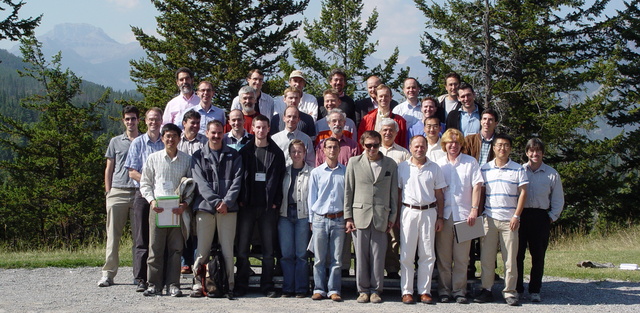Evolution of microscopic and macroscopic fields (06w5077)
Organizers
Juerg Froehlich (Swiss Institute of Technology Zuerich (ETH))
Israel Michael Sigal (University of Toronto)
Avy Soffer (Rutgers University)
Michael Weinstein (Columbia University)
Description
Modern applied mathematics grew, in a large part, out of the problems posed by classical physics, such as Celestial Mechanics, Elecro-Magnetism and Fluid Dynamics. Modern Mathematical Physics, on the other hand, has its roots in quantum theory. The latter theory explains phenomena involving atomic and subatomc particles (length scales of order of 1 Ångström or 10^{-8} cm and smaller). Its applications used to be somewhat remote and special (e.g. nuclear energetics, lasers and superconductors). This condition has changed dramatically, however, in the last few years with electronic, optical and communication devices reaching the quantum scale and with research into and the promise of quantum computing and quantum information transmission.
This new situation calls for closer integration of the applied mathematics and mathematical physics communities. The workshop hosted this week by the Banff International Research Station, September 9-14, 2006, was the first step in this direction. It brought together applied mathematicians, mathematical physicists and theoretical physicists to concentrate on the problems posed by analysis of the evolution equations of quantum physics.
There were 35 participants from Canada, France, Germany, Sweden, Switzerland, UK, US. The review talks were given by Yvan Castin (Paris), Elliott Lieb (Princeton), Igor Rodnianski (Princeton/MIT), Wilhelm Schlag (Chicago), Gora Shlyapnikov (Paris), Horng-Tser Yau (Harvard).
The Banff International Research Station for Mathematical Innovation and Discovery (BIRS) is a collaborative Canada-US-Mexico venture that provides an environment for creative interaction as well as the exchange of ideas, knowledge, and methods within the Mathematical Sciences, with related disciplines and with industry. The research station is located at The Banff Centre in Alberta and is administered by the Pacific Institute for the Mathematical Sciences, in collaboration with the Mathematics of Information Technology and Complex Systems Network (MITACS), the Berkeley-based Mathematical Science Research Institute (MSRI) and the Instituto de Matematicas at the Universidad Nacional Autonoma de Mexico (UNAM).
This new situation calls for closer integration of the applied mathematics and mathematical physics communities. The workshop hosted this week by the Banff International Research Station, September 9-14, 2006, was the first step in this direction. It brought together applied mathematicians, mathematical physicists and theoretical physicists to concentrate on the problems posed by analysis of the evolution equations of quantum physics.
There were 35 participants from Canada, France, Germany, Sweden, Switzerland, UK, US. The review talks were given by Yvan Castin (Paris), Elliott Lieb (Princeton), Igor Rodnianski (Princeton/MIT), Wilhelm Schlag (Chicago), Gora Shlyapnikov (Paris), Horng-Tser Yau (Harvard).
The Banff International Research Station for Mathematical Innovation and Discovery (BIRS) is a collaborative Canada-US-Mexico venture that provides an environment for creative interaction as well as the exchange of ideas, knowledge, and methods within the Mathematical Sciences, with related disciplines and with industry. The research station is located at The Banff Centre in Alberta and is administered by the Pacific Institute for the Mathematical Sciences, in collaboration with the Mathematics of Information Technology and Complex Systems Network (MITACS), the Berkeley-based Mathematical Science Research Institute (MSRI) and the Instituto de Matematicas at the Universidad Nacional Autonoma de Mexico (UNAM).






